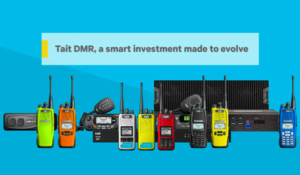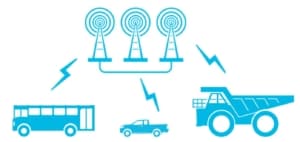Open Standards such as P25, DMR, TCP/IP and LTE offer you freedom of choice and better value for your communications investment – interoperability with other vendors means your organization can choose the right mix of equipment for the job, and can seamlessly communicate with partner agencies/organizations. As part of our longstanding commitment to interoperable, open standards-based solutions, Tait DMR has recently undergone a number of enhancements to align better with DMR standards.
Channel Authorization – user confidence in transmission
On busy systems where there are a lot of users in an area, occasionally more than one user may try to PTT at the same time. In this situation, one user will get to talk on the network and competing users may not know and incorrectly keep talking, thinking they have the floor. The result is missed calls, additional loading on the network, and highly frustrated users.
Channel Authorization provides arbitration in order that only one user will be granted permission to transmit, and all other competing users will be denied access, providing that essential user feedback. This small addition has a significant improvement to user experience, resulting in greater perception the system is working, whilst improving overall efficiency.
This feature has already been available for DMR Tier 3 Transmission Trunking, but this implementation will add floor control for high-duty-cycle users in DMR Tier 2 and Tier 3 Message Trunking. This greatly enhances safety critical operations for mining, port operations, and any other environment where robust and seamless voice delivery is essential on busy channels.
Fast Polling (USBD) – improved location services
For any organization with a large vehicle fleet, the radio network is their primary location service capability. It is therefore crucial that accurate data is sent and received by users at a rapid rate, whilst maintaining critical voice coverage. Tait Fast Polling offers a true co-existence of voice and data.
Fast Polling is achieved by utilizing the adjacent slot to the control channel, and dedicating this to data – in this case, location. It is a scalable solution, now supporting polling rates of up to 2000 polls per minute per site if using a dual control channel configuration.
For large fleets, being able to get faster location updates of staff and vehicles means more accurate information is available for a response to any incident or emergency.
Dynamic Group Number Assignment (DGNA) – flexible talk groups
Dynamic Group Number Assignment (DGNA) is the DMR Tier 3 Standard service that allows a Terminal’s talkgroup identities to be re-assigned, allowing gateways and consoles to re-assign talkgroup identities for Tier 3 Terminals, for TP9300 and TM9300.
Up to 15 talkgroup addresses can be dynamically added or removed from a terminal using the DGNA Address Mode. Talkgroups assigned by the DGNA service will be available to the terminal user for incoming and outgoing calls. The DGNA service, as well as existing Tait proprietary Dynamic Regrouping service, are available over AIS & DIP for supporting consoles and gateways.
Native Addressing – flexible numbering
Native Address is a feature which allows our terminals and Tier 3 network to access numbers that fall outside of current dial schemes or fleets. This directly improves our DMR Tier 3 standards interoperability and enhances the ability for our terminals to be configured on third party networks.
‘Flat Dialling’ is not a term that is recognized by the DMR Association or ETSI. However, in a bid to address IOP concerns, the DMRA have introduced the concept of ‘native addressing’ which seeks to ensure that a device from manufacturer A can address a device from manufacturer B, for any address in the entire addressable space of the DMR air interface.
This enhancement improves interoperability between manufacturers’ equipment, where mixed fleet support is required.
Ambient Listening (via AIS) – situational awareness
The Ambient Listening feature allows a dispatcher or other authorized user to monitor the ambient audio around a subscriber radio without any action from the user of a monitored radio. This is useful when it is thought that the user of that radio has been incapacitated, is under duress, or is otherwise in distress but unable to operate the radio manually to speak or be heard. A dispatcher or supervisor is able to use Ambient Listening to gain some situational information, helping them plan a response.
A less common, but also valuable usage scenario for this feature is if the Terminal has been stolen – the dispatcher may want to use audio streamed from the radio for tracking or evidential purposes.
Users are able to choose and program a transmit duration (length of time to allow listening) for the remote radio, ranging from 0 to 180 seconds (default 60 seconds).
 Tait DMR – Made to Evolve
Tait DMR – Made to Evolve
Tait supports open standards to give customers the freedom to choose what they need now, and the ability to adapt and evolve over time.
There are many reasons to choose Tait DMR – find out why.





